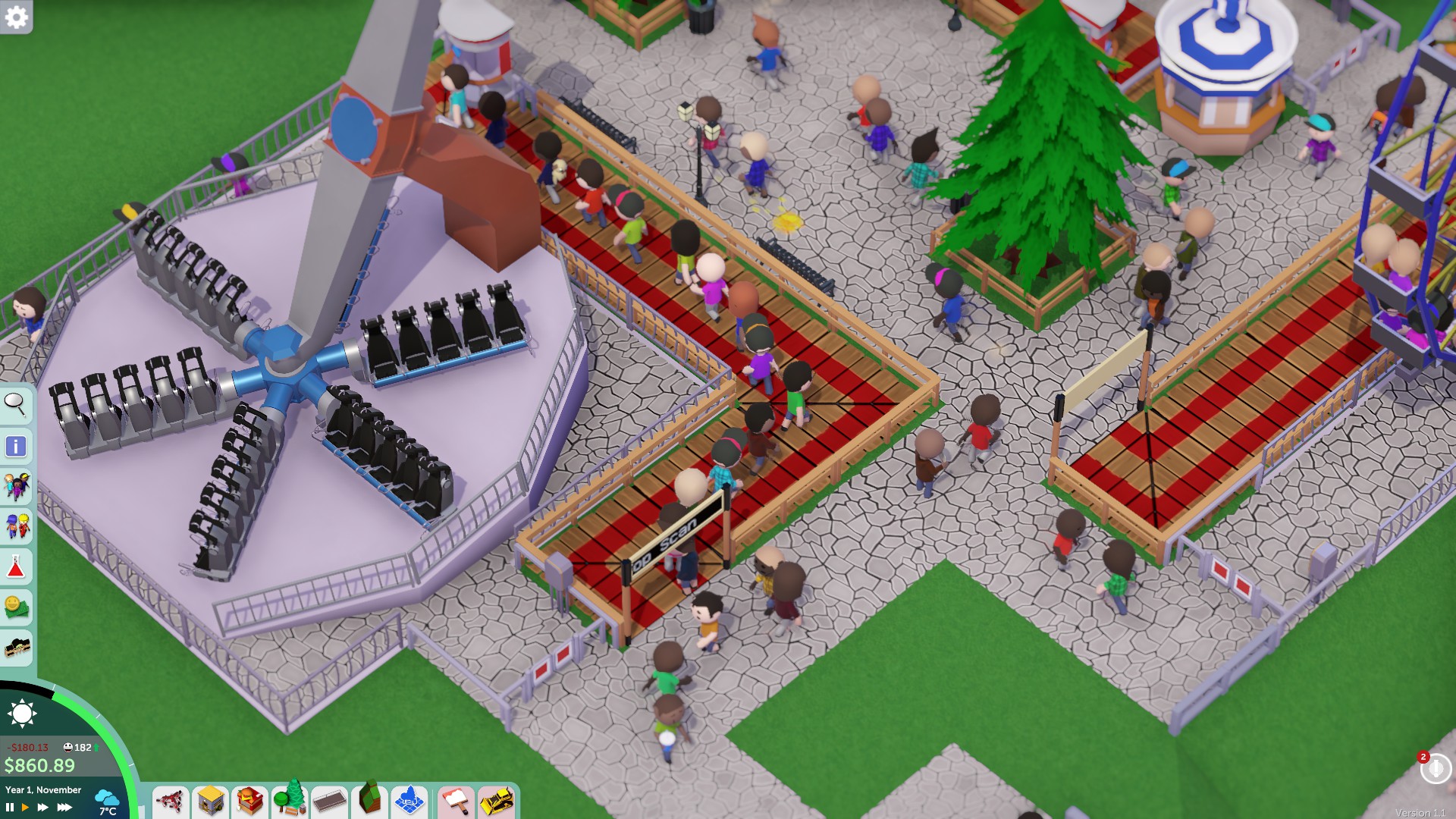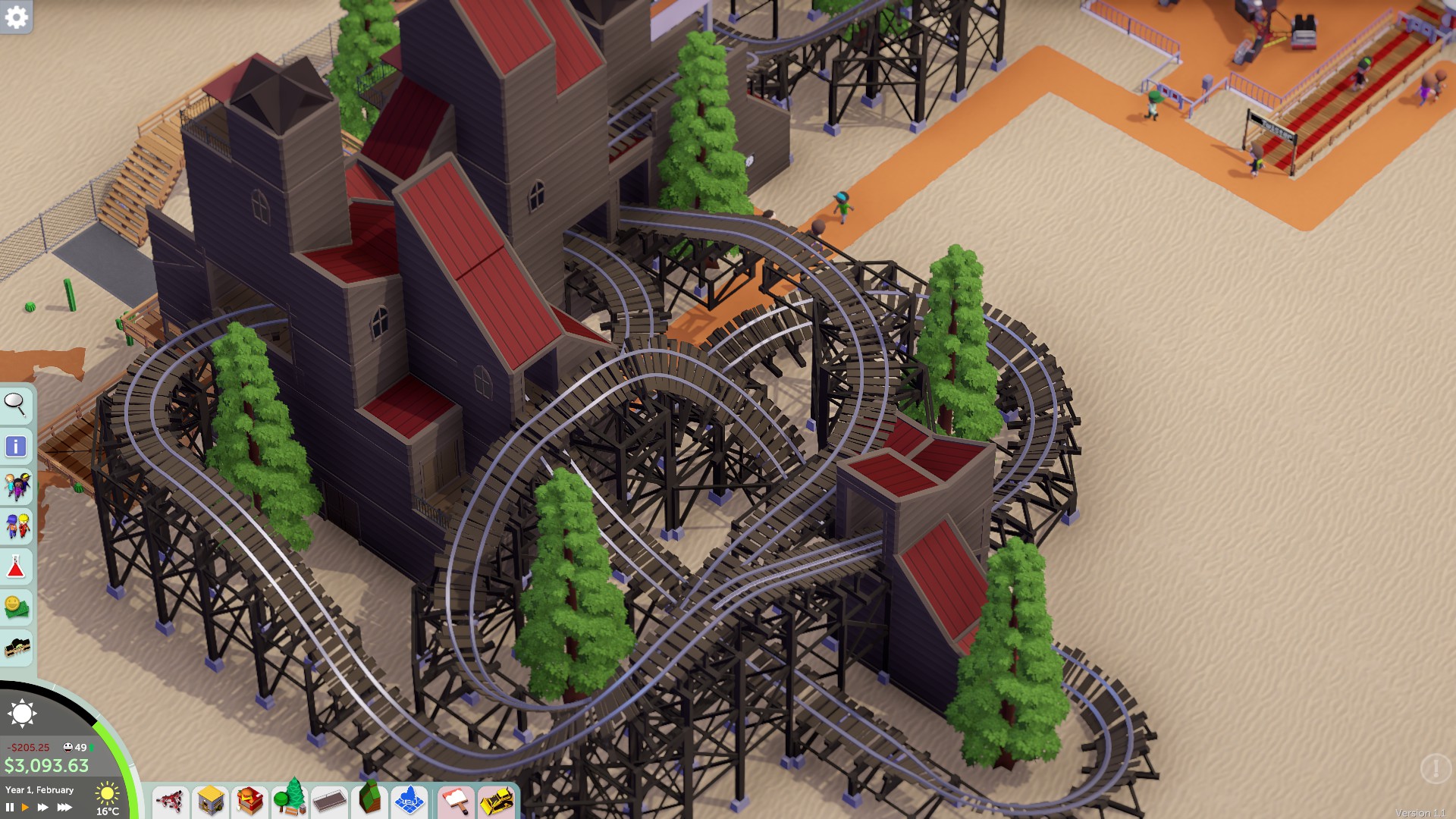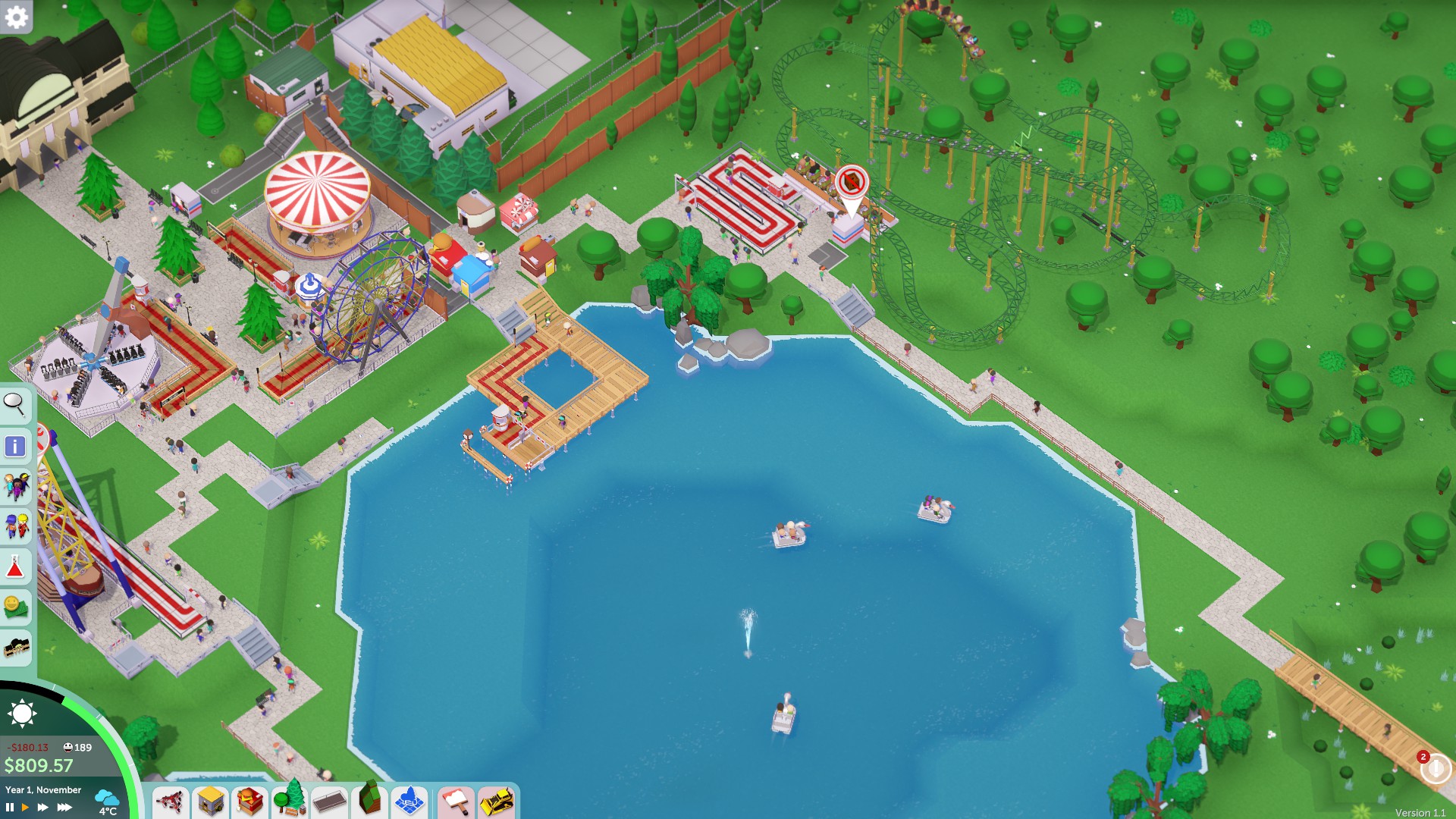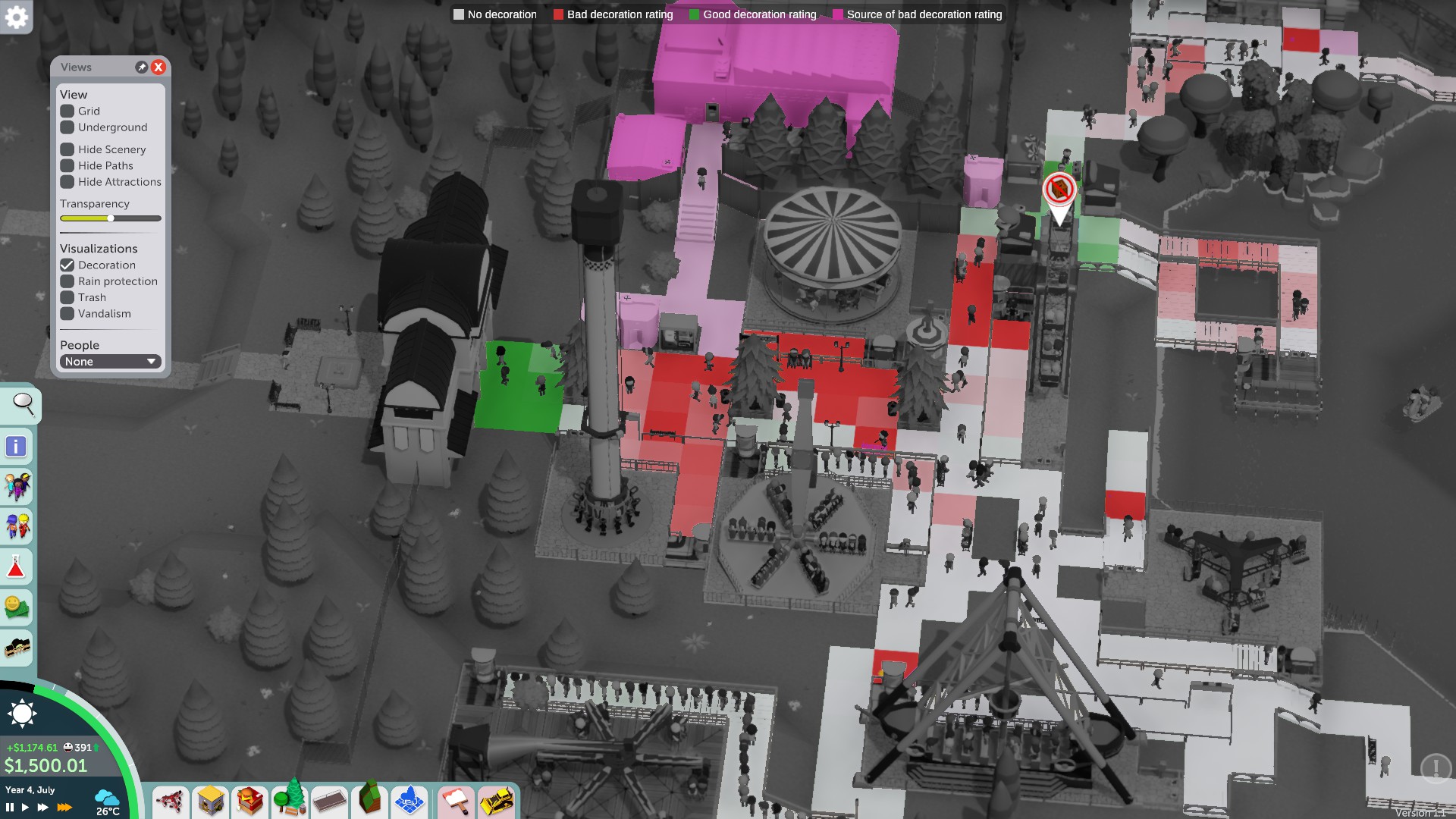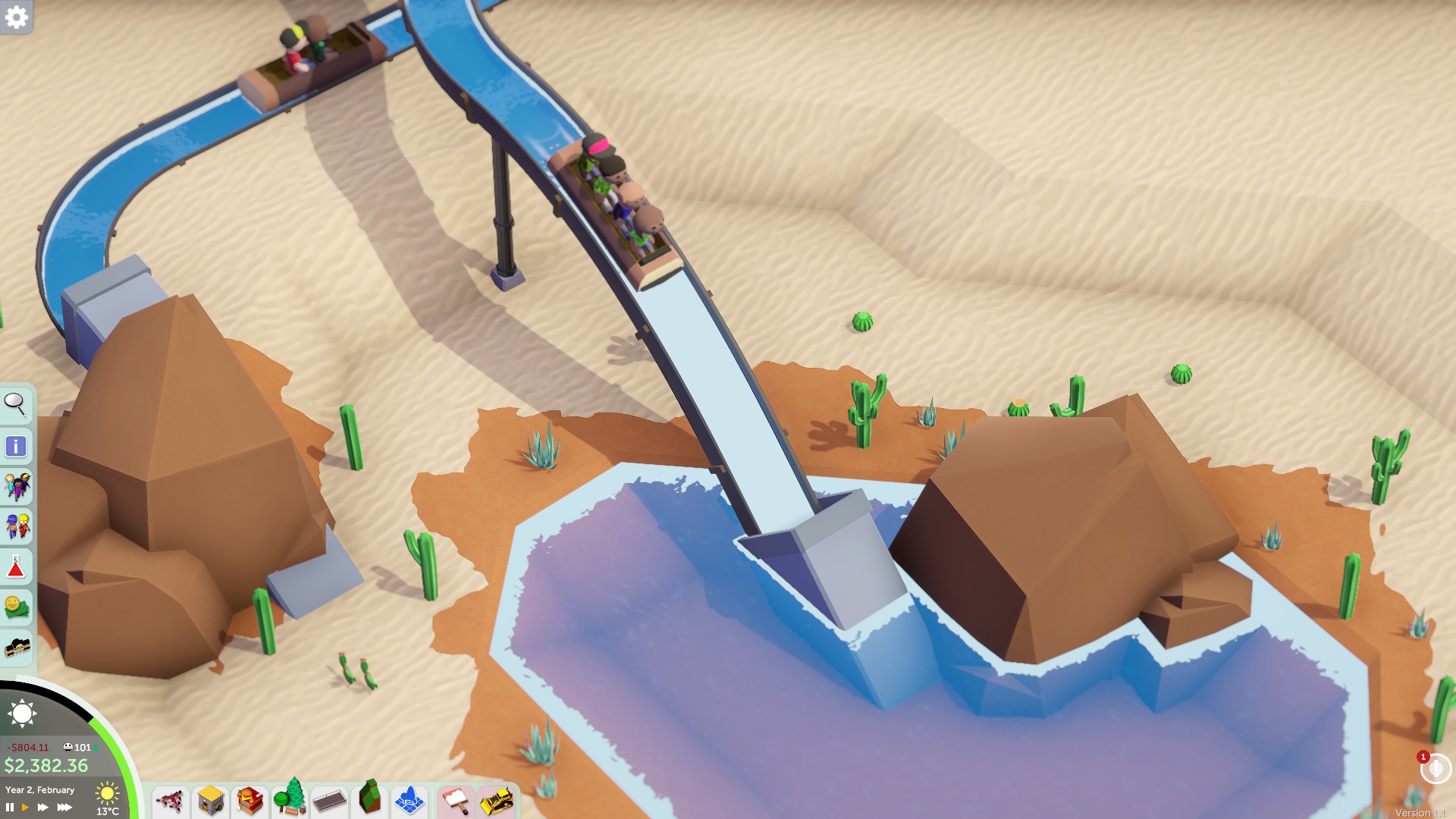Wot I Think: Parkitect
The joy of a good BLOOMP
The noisy, chaotic, and slightly illegal feel of the carnivals of my youth isn’t quite present in Parkitect. instead, its spaces are idyllic and peaceful, the twinkling lights of the Tilt-o-Whirl and Ferris wheels highlight its cheerful dioramas. The game itself is gentle with the demands it makes on you, but it gives you plenty of tools to work with. It lets you get busy right away with designing your own stomach-churning roller coasters, but if lateral-versus-vertical G-forces are a bit more than you want to take on, you can always just use designs created by other players. It’s one of the most downright pleasant things I’ve played this year, and here’s wot I think.
Things in Parkitect make a satisfying BLOOMP when you put them down, whether they’re trees or employees or rides or bins. BLOOMP. The trees shudder as a gust of air signals the arrival of something you’ve placed down. I’ve yet to grow tired of this little effect, and that bit of feedback is what encourages me to keep expanding my parks more than anything else.
You see, it isn’t particularly interested in pushing you inexorably toward the top tiers of theme park management. While you’ll have goals to meet in the campaign, you’re rarely being pushed into a panic by anything like a major catastrophe. Things are going to be just fine in this colorful little world, and you’re given the role of a benevolent theme park deity. It’s fairly easy to get your park to a point that’s financially sustainable, and once that happens you can sit back and watch as your little visitors scamper about, buying balloons and queuing up for rides.
You’ve got your pick of rides with which to amuse your adorable billiard ball-headed rabble. Install quick “midway” rides for easy fun and profit, or go in deep with a custom-designed roller coaster. And as your park grows, you can constantly fiddle with ticket and vendor prices. This is how I’ve spent most of my time, in fact. I’ve enjoyed the simple act of slowly panning around my parks, looking for long lines that might mean I can raise prices, or spotting bins that janitorial staff have neglected. I just want my little people to be happy.
It is brilliant at taking a very hands-off approach. After the first few campaign missions, you’re free to attack goals as you see fit. Sell a certain amount of tickets, say, or have a certain amount of guests. Don’t be in debt. And if you’re not interested in the whole designing roller coasters thing, Parkitect is content to let you BLOOMP down designs created by other players. Clicking the blueprints folder next to the “coasters” icon gives you a selection of the most popular designs players have constructed, and you’re free to place them just as if they were the smaller, self-contained rides of the midway, as long as you’ve researched all the necessary pieces.
However, once you’re ready to get designing, you get a robust suite of tools to work with. Coasters are constructed by beginning with a station tile, and you’ll move along your track building segment by segment, adding curves, climbs, dips, and tilt as you see fit. It can be a bit fussy at times, but you can always go back step-by-step to correct any misalignment or mistakes. You’re also free to terraform, and to send coasters underground - it’s a remarkably powerful system, as demonstrated by the amazing designs I’ve seen whilst browsing through the player creations. These are pulled into the game directly from the Steam Workshop, which is integrated into the game’s main menu.
The player-created coasters are made even more impressive with a library of props. Players have built beautiful multi-storey Italian villas surrounded by trees and topiary, with roller coaster rails that swoop through the house before re-emerging and rising into the air, doubling back to make another pass through the upper floor. Others have created haunted houses, fortresses, and ski resorts. My own creations have never been as aesthetically pleasing as the top designs on offer in the blueprints, but players with more patience than I have will be delighted with the building tools and the potential for endless fiddling.
My only gripe on this front is that the controls can be a bit of a hassle. I’ve accidentally messed up my footpaths more times than I can count by accidentally deleting things with a stray right click, and adjusting heights can be frustratingly jumpy. These are small complaints though, and because Parkitect is so unfailingly gentle, I haven’t become genuinely annoyed at anything for more than a moment. One or two BLOOMPS later, and I’m back in my meditative calm as the local god of fun things to do, listening to the happy shrieks of the riders on my roller coasters.
Since I’m not much of an engineer, I tend to focus more of my attention on the management side of things. Amusement park gods need earthly agents to help keep things running, so you’ll have to hire staff to do the unpleasant mortal business of picking up trash and keeping the stores stocked with hamburgers. Parkitect has a curious approach to labour - guests get bummed out by seeing janitors sweeping up unidentified fluids on pathways or haulers taking boxes to shops, so you’ll want to create a kind of “back stage” system of employee paths, hidden behind fences and park decorations. You can also create an underground system of chutes that whisk supplies into the park and carry trash out, and facilities like staff rooms allow your workers to rest and recharge. Handy visualizations let you easily identify areas where trash, vandalism, or immersion are becoming problems, and you can create special zones for your workers to restrict themselves to.
Parkitect’s gentle spirit extends to your visitors as well, and what you’re allowed to subject them to. Would-be evil theme park gods will be disappointed that it’s very difficult to actually injure your guests. So far, I’ve only managed to drown a handful of mine by accidentally deleting a wooden gangway they were using to cross a lake. Guests can get sick on the more intense roller coasters, but I haven’t been able to actually fling any of them across the map by deleting important segments of track. You’ve got to close a ride before you’re allowed to edit it, which forecloses any potential for real carnage.
I’ve thoroughly enjoyed my time with this endearing amusement park sim. It’s not a demanding game, and feels more like a relaxing Saturday afternoon every time I’ve opened it up to lazily tinker with my parks or try a new scenario. There’s plenty to do, and designers have the chance to compete in periodic build challenges. Winners’ creations are added to the default blueprints lists, and that has resulted in some truly impressive pieces, which I’ve been happy to BLOOMP down into my own parks. It’s a game that I’ve been content to just watch for long stretches at a time, just sweeping my gaze around the blocky, cheerful landscapes and watching my visitors roaming around, buying my umbrellas and lining up to board the Gravitron or take one of the swan paddleboats out for a spin.
I’ve missed out on Roller Coaster Tycoon and its descendants, so I can’t compare Parkitect to those games. What I can say is that it is delightful and non-threatening, and playing it has typically left me feeling pleasantly drowsy and contented, the way I might after wandering around a brightly-lit midway, munching a corn dog covered in mustard in a gauzy childhood memory of the carnival.


